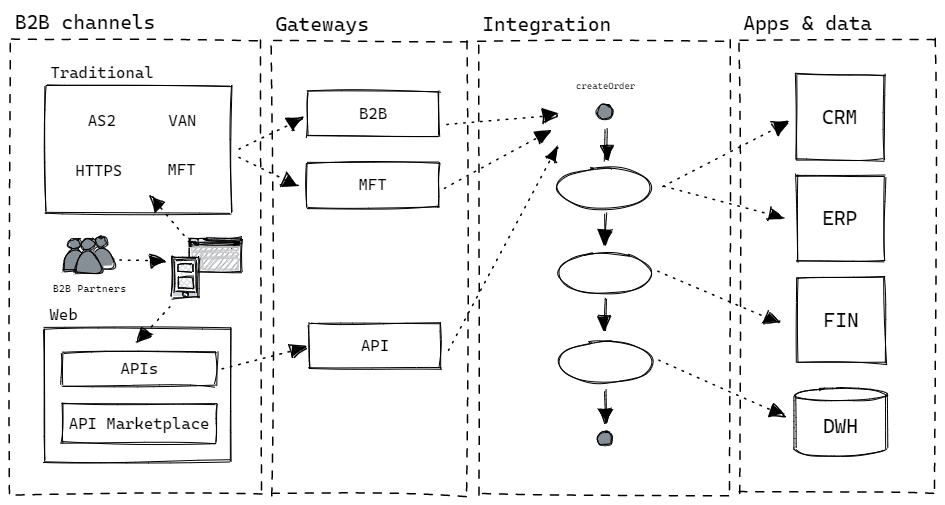Modernize your B2B ecosystem with API integration
Gartner predicts that “by 2023, over 50% of B2B transactions will be performed through real-time APIs versus traditional approaches.” Now more than ever, APIs complement rather than replace traditional B2B technologies like EDI and MFT.

Gartner predicts that “by 2023, over 50% of B2B transactions will be performed through real-time APIs versus traditional approaches.” Some claim that EDI is dead, and APIs will be the heir as the de facto standard for how data is exchanged between organizations. The truth is that APIs complement rather than replace traditional B2B technologies like EDI and MFT. In this blog post, we will explore what a modern B2B strategy looks like and what webMethods.io can do for you to help you implement it.
Tools for the trade, fit for purpose
B2B is a varied trade, where you need to consider how needs may differ between organizations in your ecosystem. Large companies have leverage to dictate what kind of B2B communications they want to use. On the other end, you have companies that are met with demands from their larger partners, and they are burdened with supporting all these standards and technologies.
Knowing that you will be confronted with different standards and technologies, it is important to understand their benefits and drawbacks. Let’s broadly categorize them as traditional B2B and APIs.
- Traditional B2B communications are built around rich and standardized message formats like EDIFACT and X12. They were designed for scheduled, file-based data exchanges, which does imply a lag in processing. Thanks to the high degree of standardization, and by using a great B2B and MFT solution, you do not need to rely on developers for integrating new partners. Partner onboarding can be performed by business operations staff or can even be automated completely.
- B2B APIs enable real-time processing of data and direct integration into your business processes and systems, which help you to increase value chain intimacy. When done right, APIs deliver full transparency on processing status, faster process execution, and a quicker time to resolution for errors. All greatly benefit the experience you deliver to your customers. APIs are built for developers, which does imply that you need a developer or a great iPaaS solution to consume them. Another caveat is that APIs are typically designed around ecosystem requirements and the provider’s own internal data models. Because these differ between organizations, B2B API definitions defined by different organizations in the same industry are typically completely different.
Because both approaches have their benefits and drawbacks, they are best suited for different use cases and are thus complementary. Traditional B2B integration is great for standardized communications where real-time processing is not needed. You can use APIs to add new channels, enable automation, and optimize your business ecosystem for digital business where traditional B2B integration is less suited.
Integrate to consolidate
When you use APIs as a new B2B channel, you must reconcile this approach with your traditional B2B integration channels. Some B2B partners will use either or both approaches and you will need to ensure you deliver the same quality of service, irrespective of the channel they use.
You’re likely also using APIs in other areas within your business. Most businesses have digital transformation initiatives underway that modernize or transform existing systems and add new digital capabilities and business models. APIs are the interfaces of the new services that are created and connect systems and automate business processes. You’ll need to align your B2B integration channels with the broader, integrated architecture. One way of solving this challenge is to design your B2B integration channels as gateways that tie into the api integration infrastructure that glues the rest of your architecture together and automates your business processes.

With such a scalable, extensive B2B architecture you can enable richer, faster, and real-time integration. All while continuing to serve traditional channels and reusing existing automation.
Multi-function integration platform
With webMethods, you can scale, pivot, and perfect your approach to B2B integration. webMethods provides a multi-function integration platform that helps you create, connect, and manage your B2B ecosystem. It is recognized as an industry leader for B2B, MFT, API Management, and iPaaS, and provides you with all the necessary capabilities to establish a scalable and flexible B2B architecture to underpin your business ecosystem.